Critical Analysis of Blockchain Architecture
VerifiedAdded on 2023/06/01
|18
|5267
|383
AI Summary
This paper analyses the various aspects of blockchain architecture, including its structure, purpose, key characteristics, and consensus algorithms. It also discusses the advantages and disadvantages of utilising blockchain architecture and potential improvements.
Contribute Materials
Your contribution can guide someone’s learning journey. Share your
documents today.
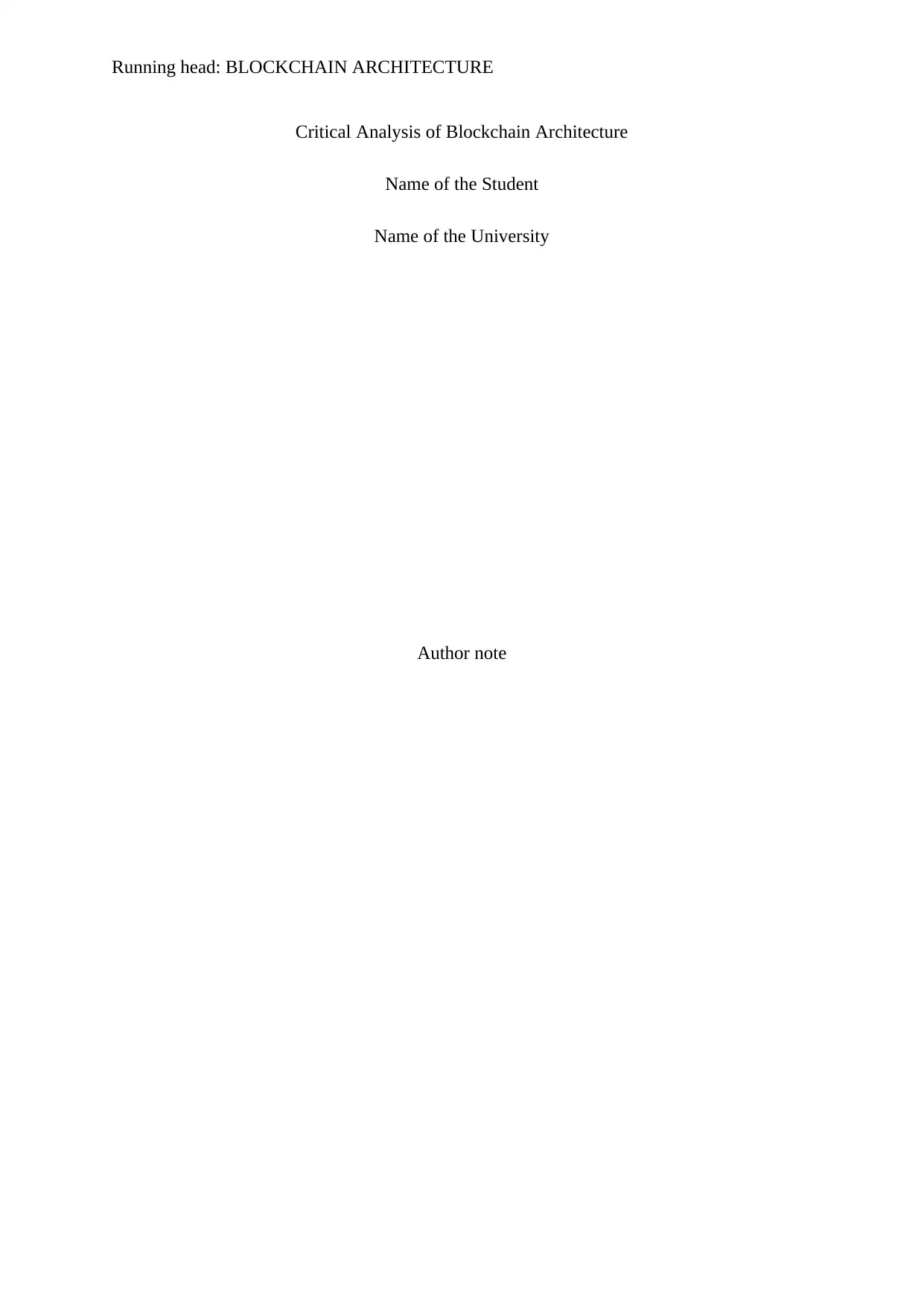
Running head: BLOCKCHAIN ARCHITECTURE
Critical Analysis of Blockchain Architecture
Name of the Student
Name of the University
Author note
Critical Analysis of Blockchain Architecture
Name of the Student
Name of the University
Author note
Secure Best Marks with AI Grader
Need help grading? Try our AI Grader for instant feedback on your assignments.
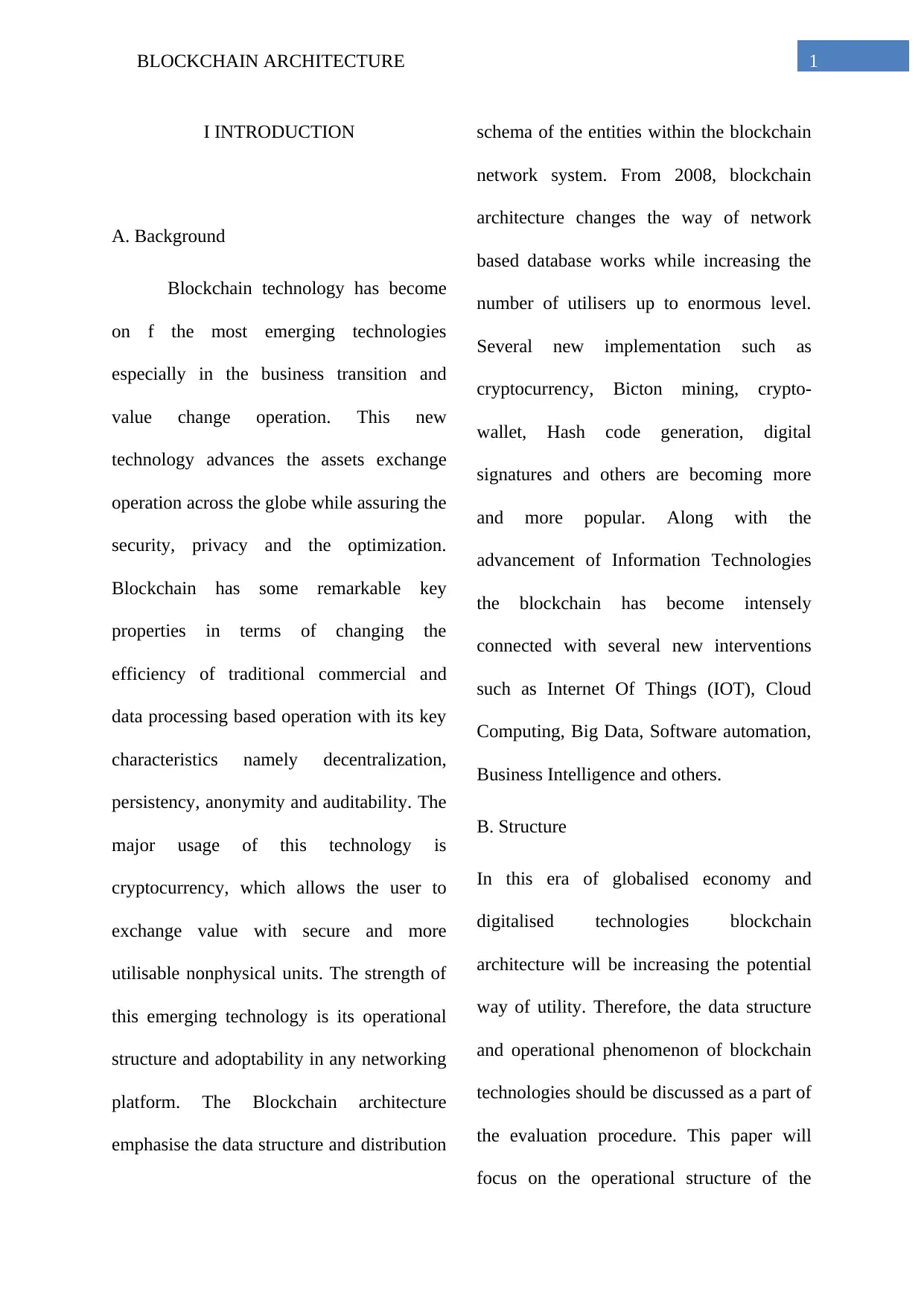
1BLOCKCHAIN ARCHITECTURE
I INTRODUCTION
A. Background
Blockchain technology has become
on f the most emerging technologies
especially in the business transition and
value change operation. This new
technology advances the assets exchange
operation across the globe while assuring the
security, privacy and the optimization.
Blockchain has some remarkable key
properties in terms of changing the
efficiency of traditional commercial and
data processing based operation with its key
characteristics namely decentralization,
persistency, anonymity and auditability. The
major usage of this technology is
cryptocurrency, which allows the user to
exchange value with secure and more
utilisable nonphysical units. The strength of
this emerging technology is its operational
structure and adoptability in any networking
platform. The Blockchain architecture
emphasise the data structure and distribution
schema of the entities within the blockchain
network system. From 2008, blockchain
architecture changes the way of network
based database works while increasing the
number of utilisers up to enormous level.
Several new implementation such as
cryptocurrency, Bicton mining, crypto-
wallet, Hash code generation, digital
signatures and others are becoming more
and more popular. Along with the
advancement of Information Technologies
the blockchain has become intensely
connected with several new interventions
such as Internet Of Things (IOT), Cloud
Computing, Big Data, Software automation,
Business Intelligence and others.
B. Structure
In this era of globalised economy and
digitalised technologies blockchain
architecture will be increasing the potential
way of utility. Therefore, the data structure
and operational phenomenon of blockchain
technologies should be discussed as a part of
the evaluation procedure. This paper will
focus on the operational structure of the
I INTRODUCTION
A. Background
Blockchain technology has become
on f the most emerging technologies
especially in the business transition and
value change operation. This new
technology advances the assets exchange
operation across the globe while assuring the
security, privacy and the optimization.
Blockchain has some remarkable key
properties in terms of changing the
efficiency of traditional commercial and
data processing based operation with its key
characteristics namely decentralization,
persistency, anonymity and auditability. The
major usage of this technology is
cryptocurrency, which allows the user to
exchange value with secure and more
utilisable nonphysical units. The strength of
this emerging technology is its operational
structure and adoptability in any networking
platform. The Blockchain architecture
emphasise the data structure and distribution
schema of the entities within the blockchain
network system. From 2008, blockchain
architecture changes the way of network
based database works while increasing the
number of utilisers up to enormous level.
Several new implementation such as
cryptocurrency, Bicton mining, crypto-
wallet, Hash code generation, digital
signatures and others are becoming more
and more popular. Along with the
advancement of Information Technologies
the blockchain has become intensely
connected with several new interventions
such as Internet Of Things (IOT), Cloud
Computing, Big Data, Software automation,
Business Intelligence and others.
B. Structure
In this era of globalised economy and
digitalised technologies blockchain
architecture will be increasing the potential
way of utility. Therefore, the data structure
and operational phenomenon of blockchain
technologies should be discussed as a part of
the evaluation procedure. This paper will
focus on the operational structure of the
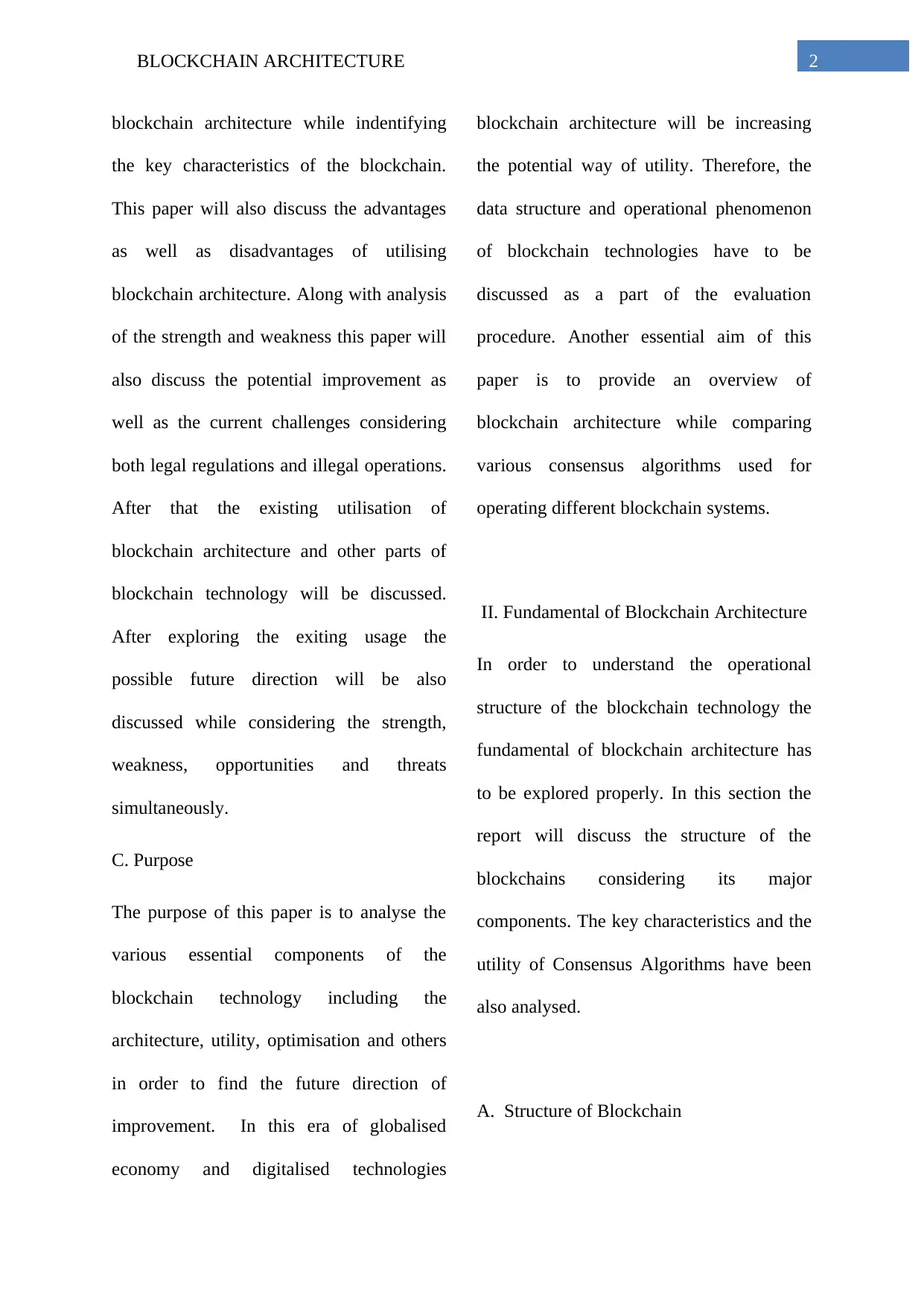
2BLOCKCHAIN ARCHITECTURE
blockchain architecture while indentifying
the key characteristics of the blockchain.
This paper will also discuss the advantages
as well as disadvantages of utilising
blockchain architecture. Along with analysis
of the strength and weakness this paper will
also discuss the potential improvement as
well as the current challenges considering
both legal regulations and illegal operations.
After that the existing utilisation of
blockchain architecture and other parts of
blockchain technology will be discussed.
After exploring the exiting usage the
possible future direction will be also
discussed while considering the strength,
weakness, opportunities and threats
simultaneously.
C. Purpose
The purpose of this paper is to analyse the
various essential components of the
blockchain technology including the
architecture, utility, optimisation and others
in order to find the future direction of
improvement. In this era of globalised
economy and digitalised technologies
blockchain architecture will be increasing
the potential way of utility. Therefore, the
data structure and operational phenomenon
of blockchain technologies have to be
discussed as a part of the evaluation
procedure. Another essential aim of this
paper is to provide an overview of
blockchain architecture while comparing
various consensus algorithms used for
operating different blockchain systems.
II. Fundamental of Blockchain Architecture
In order to understand the operational
structure of the blockchain technology the
fundamental of blockchain architecture has
to be explored properly. In this section the
report will discuss the structure of the
blockchains considering its major
components. The key characteristics and the
utility of Consensus Algorithms have been
also analysed.
A. Structure of Blockchain
blockchain architecture while indentifying
the key characteristics of the blockchain.
This paper will also discuss the advantages
as well as disadvantages of utilising
blockchain architecture. Along with analysis
of the strength and weakness this paper will
also discuss the potential improvement as
well as the current challenges considering
both legal regulations and illegal operations.
After that the existing utilisation of
blockchain architecture and other parts of
blockchain technology will be discussed.
After exploring the exiting usage the
possible future direction will be also
discussed while considering the strength,
weakness, opportunities and threats
simultaneously.
C. Purpose
The purpose of this paper is to analyse the
various essential components of the
blockchain technology including the
architecture, utility, optimisation and others
in order to find the future direction of
improvement. In this era of globalised
economy and digitalised technologies
blockchain architecture will be increasing
the potential way of utility. Therefore, the
data structure and operational phenomenon
of blockchain technologies have to be
discussed as a part of the evaluation
procedure. Another essential aim of this
paper is to provide an overview of
blockchain architecture while comparing
various consensus algorithms used for
operating different blockchain systems.
II. Fundamental of Blockchain Architecture
In order to understand the operational
structure of the blockchain technology the
fundamental of blockchain architecture has
to be explored properly. In this section the
report will discuss the structure of the
blockchains considering its major
components. The key characteristics and the
utility of Consensus Algorithms have been
also analysed.
A. Structure of Blockchain
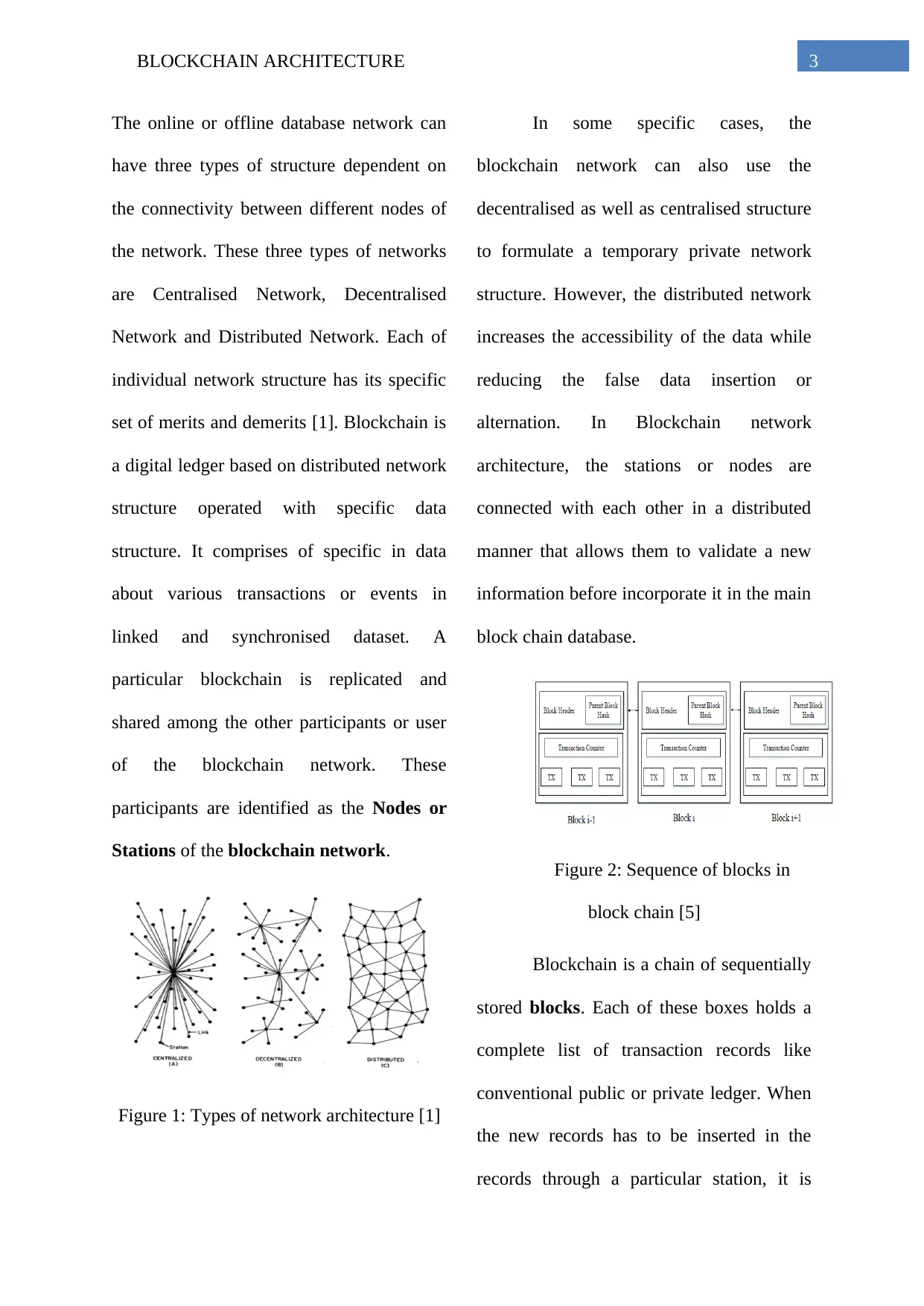
3BLOCKCHAIN ARCHITECTURE
The online or offline database network can
have three types of structure dependent on
the connectivity between different nodes of
the network. These three types of networks
are Centralised Network, Decentralised
Network and Distributed Network. Each of
individual network structure has its specific
set of merits and demerits [1]. Blockchain is
a digital ledger based on distributed network
structure operated with specific data
structure. It comprises of specific in data
about various transactions or events in
linked and synchronised dataset. A
particular blockchain is replicated and
shared among the other participants or user
of the blockchain network. These
participants are identified as the Nodes or
Stations of the blockchain network.
Figure 1: Types of network architecture [1]
In some specific cases, the
blockchain network can also use the
decentralised as well as centralised structure
to formulate a temporary private network
structure. However, the distributed network
increases the accessibility of the data while
reducing the false data insertion or
alternation. In Blockchain network
architecture, the stations or nodes are
connected with each other in a distributed
manner that allows them to validate a new
information before incorporate it in the main
block chain database.
Figure 2: Sequence of blocks in
block chain [5]
Blockchain is a chain of sequentially
stored blocks. Each of these boxes holds a
complete list of transaction records like
conventional public or private ledger. When
the new records has to be inserted in the
records through a particular station, it is
The online or offline database network can
have three types of structure dependent on
the connectivity between different nodes of
the network. These three types of networks
are Centralised Network, Decentralised
Network and Distributed Network. Each of
individual network structure has its specific
set of merits and demerits [1]. Blockchain is
a digital ledger based on distributed network
structure operated with specific data
structure. It comprises of specific in data
about various transactions or events in
linked and synchronised dataset. A
particular blockchain is replicated and
shared among the other participants or user
of the blockchain network. These
participants are identified as the Nodes or
Stations of the blockchain network.
Figure 1: Types of network architecture [1]
In some specific cases, the
blockchain network can also use the
decentralised as well as centralised structure
to formulate a temporary private network
structure. However, the distributed network
increases the accessibility of the data while
reducing the false data insertion or
alternation. In Blockchain network
architecture, the stations or nodes are
connected with each other in a distributed
manner that allows them to validate a new
information before incorporate it in the main
block chain database.
Figure 2: Sequence of blocks in
block chain [5]
Blockchain is a chain of sequentially
stored blocks. Each of these boxes holds a
complete list of transaction records like
conventional public or private ledger. When
the new records has to be inserted in the
records through a particular station, it is
Secure Best Marks with AI Grader
Need help grading? Try our AI Grader for instant feedback on your assignments.

4BLOCKCHAIN ARCHITECTURE
recorded in a new block created after
approval from the other sections of the
network [6]. In this way the old records
remain unchanged and unforgeable. The
new blocks contains the address of the
previous block which contain the older
record. The address of the block is encrypted
in a Hash address, which can be decrypted
through authorised permission. Blockchain
has adopted this information handling
strategy from the ancient use of
Cryptography. The structure of the block is
subdivided into 2 sections namely the block
header and Transaction counter. The
transaction canters store the transaction
record and the header block stores the record
and block properties including parent block
Hash address, nBits, Nonce and others.
Figure 3: Structure of the Block [3]
Hash code is the most essential part
of the block chain technology which ensure
the security of the blocks address. The Hash
code is a encrypted code that consists of the
location of the blockchain as well as the
address of the target blocks with its
sequence. As discussed earlier the purpose
of the blockchain architecture is to maintain
a secure and distributed ledger. When an
new transaction needs initiation the sender
node or station request the blockchain
network to initiate the transaction process.
In this phase sender applies for the
transaction with the Public key of the
receiver. This public key consists of the
encrypted block chain address. After
analysing the authenticity of the proposer
after comparing with the Private key from
the receiver side, the connected nodes
initiate the new block developing procedure.
In this phase the new block with transaction
records is added in the next position of the
last block of the target blockchain.
recorded in a new block created after
approval from the other sections of the
network [6]. In this way the old records
remain unchanged and unforgeable. The
new blocks contains the address of the
previous block which contain the older
record. The address of the block is encrypted
in a Hash address, which can be decrypted
through authorised permission. Blockchain
has adopted this information handling
strategy from the ancient use of
Cryptography. The structure of the block is
subdivided into 2 sections namely the block
header and Transaction counter. The
transaction canters store the transaction
record and the header block stores the record
and block properties including parent block
Hash address, nBits, Nonce and others.
Figure 3: Structure of the Block [3]
Hash code is the most essential part
of the block chain technology which ensure
the security of the blocks address. The Hash
code is a encrypted code that consists of the
location of the blockchain as well as the
address of the target blocks with its
sequence. As discussed earlier the purpose
of the blockchain architecture is to maintain
a secure and distributed ledger. When an
new transaction needs initiation the sender
node or station request the blockchain
network to initiate the transaction process.
In this phase sender applies for the
transaction with the Public key of the
receiver. This public key consists of the
encrypted block chain address. After
analysing the authenticity of the proposer
after comparing with the Private key from
the receiver side, the connected nodes
initiate the new block developing procedure.
In this phase the new block with transaction
records is added in the next position of the
last block of the target blockchain.
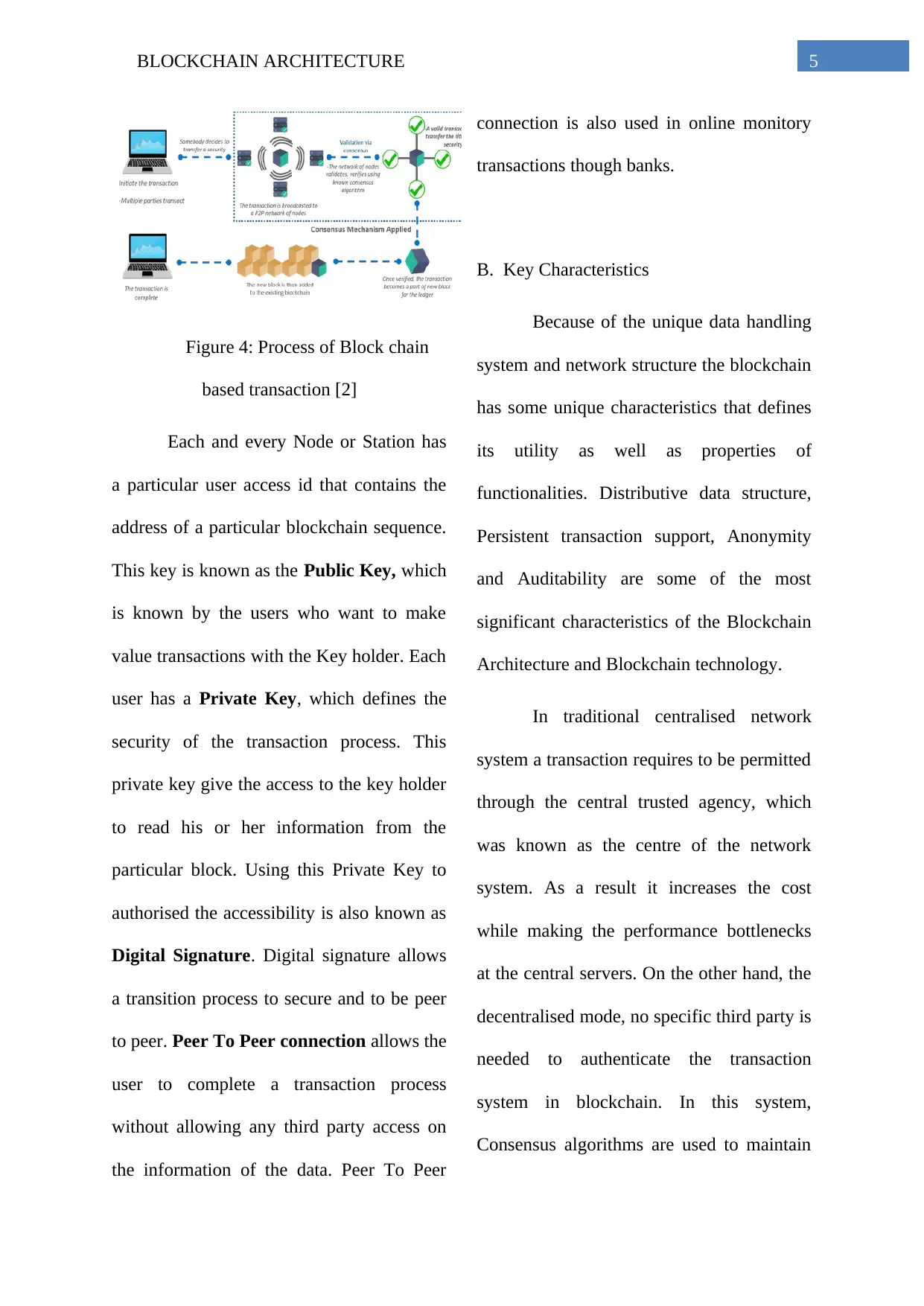
5BLOCKCHAIN ARCHITECTURE
Figure 4: Process of Block chain
based transaction [2]
Each and every Node or Station has
a particular user access id that contains the
address of a particular blockchain sequence.
This key is known as the Public Key, which
is known by the users who want to make
value transactions with the Key holder. Each
user has a Private Key, which defines the
security of the transaction process. This
private key give the access to the key holder
to read his or her information from the
particular block. Using this Private Key to
authorised the accessibility is also known as
Digital Signature. Digital signature allows
a transition process to secure and to be peer
to peer. Peer To Peer connection allows the
user to complete a transaction process
without allowing any third party access on
the information of the data. Peer To Peer
connection is also used in online monitory
transactions though banks.
B. Key Characteristics
Because of the unique data handling
system and network structure the blockchain
has some unique characteristics that defines
its utility as well as properties of
functionalities. Distributive data structure,
Persistent transaction support, Anonymity
and Auditability are some of the most
significant characteristics of the Blockchain
Architecture and Blockchain technology.
In traditional centralised network
system a transaction requires to be permitted
through the central trusted agency, which
was known as the centre of the network
system. As a result it increases the cost
while making the performance bottlenecks
at the central servers. On the other hand, the
decentralised mode, no specific third party is
needed to authenticate the transaction
system in blockchain. In this system,
Consensus algorithms are used to maintain
Figure 4: Process of Block chain
based transaction [2]
Each and every Node or Station has
a particular user access id that contains the
address of a particular blockchain sequence.
This key is known as the Public Key, which
is known by the users who want to make
value transactions with the Key holder. Each
user has a Private Key, which defines the
security of the transaction process. This
private key give the access to the key holder
to read his or her information from the
particular block. Using this Private Key to
authorised the accessibility is also known as
Digital Signature. Digital signature allows
a transition process to secure and to be peer
to peer. Peer To Peer connection allows the
user to complete a transaction process
without allowing any third party access on
the information of the data. Peer To Peer
connection is also used in online monitory
transactions though banks.
B. Key Characteristics
Because of the unique data handling
system and network structure the blockchain
has some unique characteristics that defines
its utility as well as properties of
functionalities. Distributive data structure,
Persistent transaction support, Anonymity
and Auditability are some of the most
significant characteristics of the Blockchain
Architecture and Blockchain technology.
In traditional centralised network
system a transaction requires to be permitted
through the central trusted agency, which
was known as the centre of the network
system. As a result it increases the cost
while making the performance bottlenecks
at the central servers. On the other hand, the
decentralised mode, no specific third party is
needed to authenticate the transaction
system in blockchain. In this system,
Consensus algorithms are used to maintain
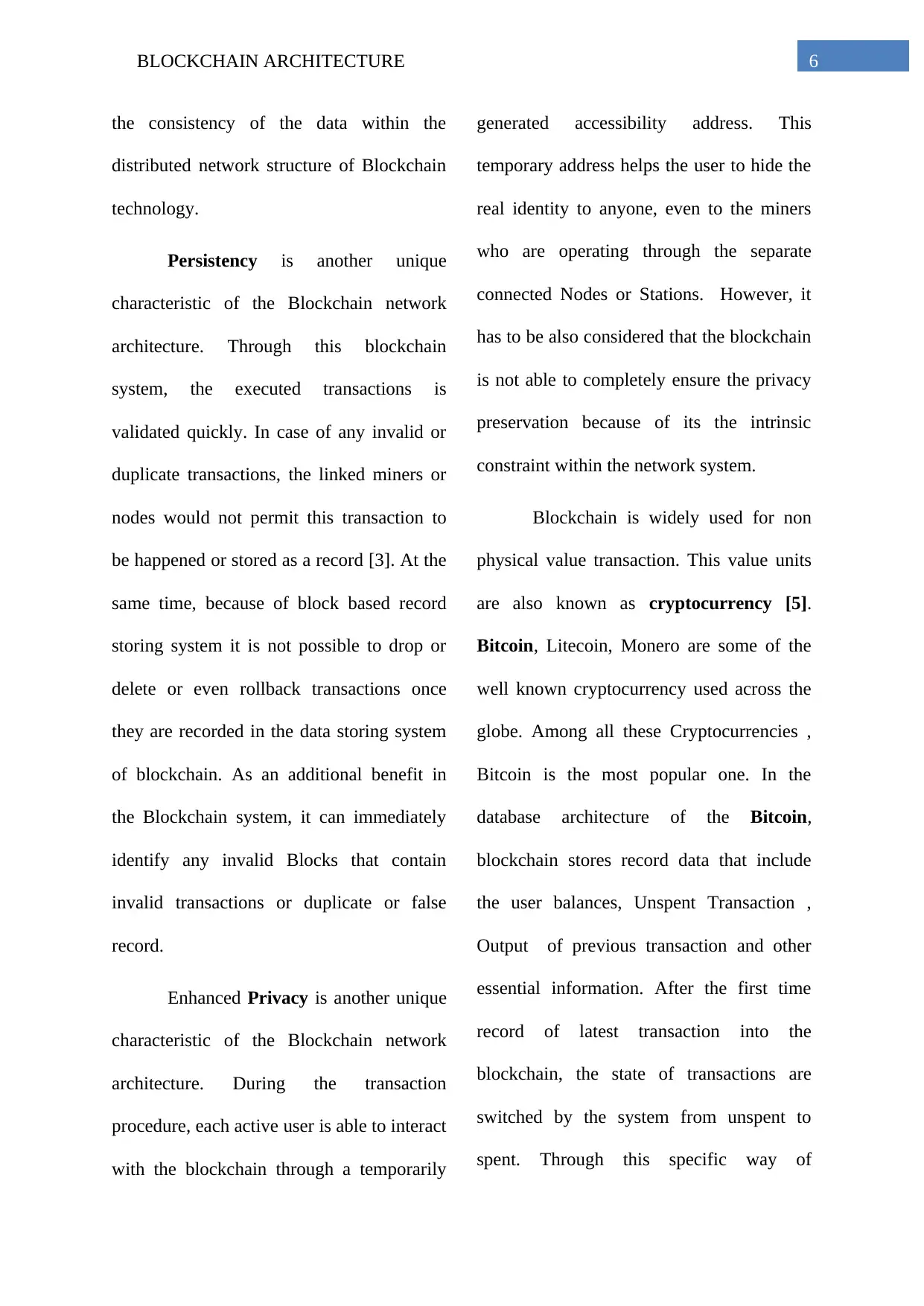
6BLOCKCHAIN ARCHITECTURE
the consistency of the data within the
distributed network structure of Blockchain
technology.
Persistency is another unique
characteristic of the Blockchain network
architecture. Through this blockchain
system, the executed transactions is
validated quickly. In case of any invalid or
duplicate transactions, the linked miners or
nodes would not permit this transaction to
be happened or stored as a record [3]. At the
same time, because of block based record
storing system it is not possible to drop or
delete or even rollback transactions once
they are recorded in the data storing system
of blockchain. As an additional benefit in
the Blockchain system, it can immediately
identify any invalid Blocks that contain
invalid transactions or duplicate or false
record.
Enhanced Privacy is another unique
characteristic of the Blockchain network
architecture. During the transaction
procedure, each active user is able to interact
with the blockchain through a temporarily
generated accessibility address. This
temporary address helps the user to hide the
real identity to anyone, even to the miners
who are operating through the separate
connected Nodes or Stations. However, it
has to be also considered that the blockchain
is not able to completely ensure the privacy
preservation because of its the intrinsic
constraint within the network system.
Blockchain is widely used for non
physical value transaction. This value units
are also known as cryptocurrency [5].
Bitcoin, Litecoin, Monero are some of the
well known cryptocurrency used across the
globe. Among all these Cryptocurrencies ,
Bitcoin is the most popular one. In the
database architecture of the Bitcoin,
blockchain stores record data that include
the user balances, Unspent Transaction ,
Output of previous transaction and other
essential information. After the first time
record of latest transaction into the
blockchain, the state of transactions are
switched by the system from unspent to
spent. Through this specific way of
the consistency of the data within the
distributed network structure of Blockchain
technology.
Persistency is another unique
characteristic of the Blockchain network
architecture. Through this blockchain
system, the executed transactions is
validated quickly. In case of any invalid or
duplicate transactions, the linked miners or
nodes would not permit this transaction to
be happened or stored as a record [3]. At the
same time, because of block based record
storing system it is not possible to drop or
delete or even rollback transactions once
they are recorded in the data storing system
of blockchain. As an additional benefit in
the Blockchain system, it can immediately
identify any invalid Blocks that contain
invalid transactions or duplicate or false
record.
Enhanced Privacy is another unique
characteristic of the Blockchain network
architecture. During the transaction
procedure, each active user is able to interact
with the blockchain through a temporarily
generated accessibility address. This
temporary address helps the user to hide the
real identity to anyone, even to the miners
who are operating through the separate
connected Nodes or Stations. However, it
has to be also considered that the blockchain
is not able to completely ensure the privacy
preservation because of its the intrinsic
constraint within the network system.
Blockchain is widely used for non
physical value transaction. This value units
are also known as cryptocurrency [5].
Bitcoin, Litecoin, Monero are some of the
well known cryptocurrency used across the
globe. Among all these Cryptocurrencies ,
Bitcoin is the most popular one. In the
database architecture of the Bitcoin,
blockchain stores record data that include
the user balances, Unspent Transaction ,
Output of previous transaction and other
essential information. After the first time
record of latest transaction into the
blockchain, the state of transactions are
switched by the system from unspent to
spent. Through this specific way of
Paraphrase This Document
Need a fresh take? Get an instant paraphrase of this document with our AI Paraphraser
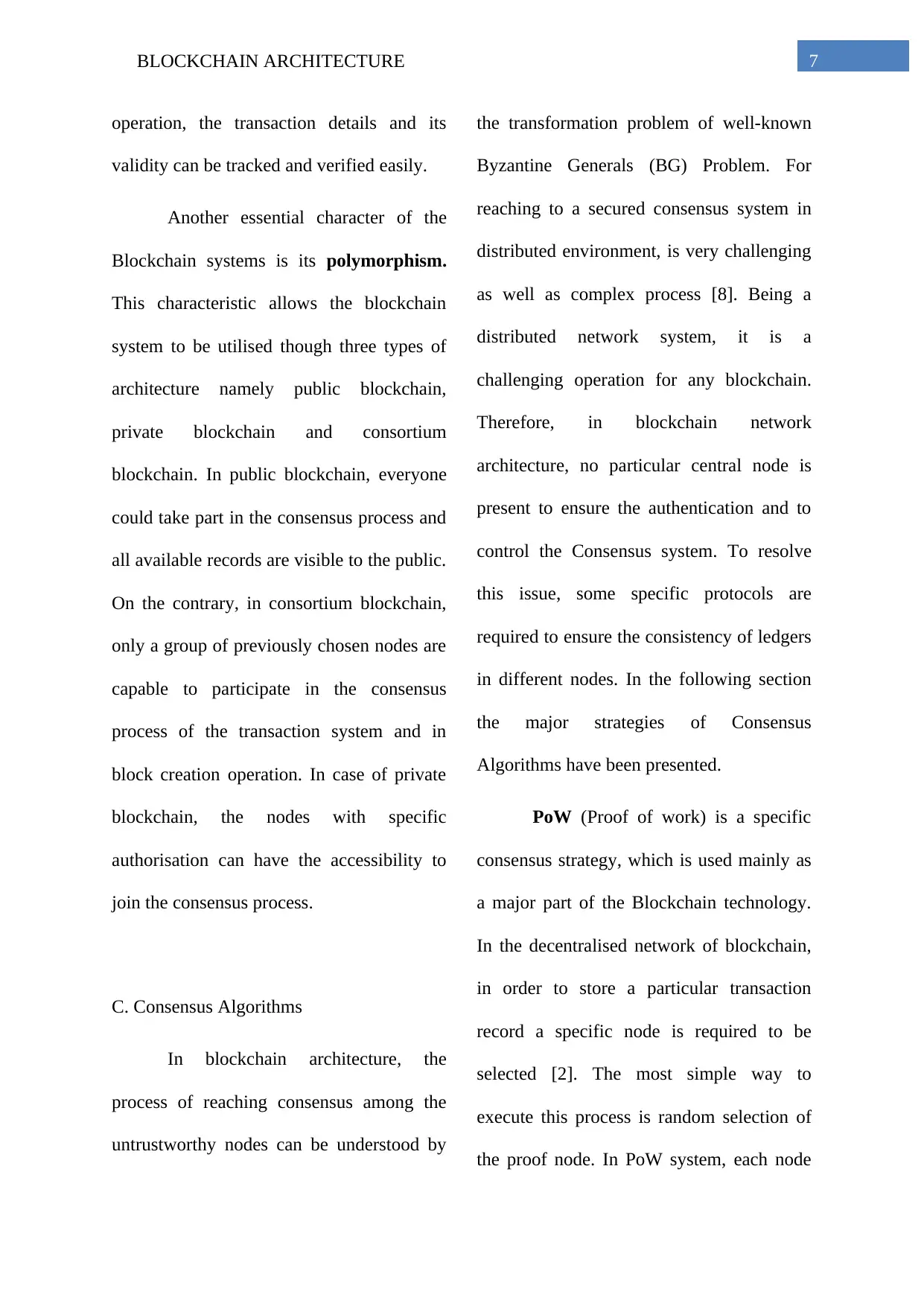
7BLOCKCHAIN ARCHITECTURE
operation, the transaction details and its
validity can be tracked and verified easily.
Another essential character of the
Blockchain systems is its polymorphism.
This characteristic allows the blockchain
system to be utilised though three types of
architecture namely public blockchain,
private blockchain and consortium
blockchain. In public blockchain, everyone
could take part in the consensus process and
all available records are visible to the public.
On the contrary, in consortium blockchain,
only a group of previously chosen nodes are
capable to participate in the consensus
process of the transaction system and in
block creation operation. In case of private
blockchain, the nodes with specific
authorisation can have the accessibility to
join the consensus process.
C. Consensus Algorithms
In blockchain architecture, the
process of reaching consensus among the
untrustworthy nodes can be understood by
the transformation problem of well-known
Byzantine Generals (BG) Problem. For
reaching to a secured consensus system in
distributed environment, is very challenging
as well as complex process [8]. Being a
distributed network system, it is a
challenging operation for any blockchain.
Therefore, in blockchain network
architecture, no particular central node is
present to ensure the authentication and to
control the Consensus system. To resolve
this issue, some specific protocols are
required to ensure the consistency of ledgers
in different nodes. In the following section
the major strategies of Consensus
Algorithms have been presented.
PoW (Proof of work) is a specific
consensus strategy, which is used mainly as
a major part of the Blockchain technology.
In the decentralised network of blockchain,
in order to store a particular transaction
record a specific node is required to be
selected [2]. The most simple way to
execute this process is random selection of
the proof node. In PoW system, each node
operation, the transaction details and its
validity can be tracked and verified easily.
Another essential character of the
Blockchain systems is its polymorphism.
This characteristic allows the blockchain
system to be utilised though three types of
architecture namely public blockchain,
private blockchain and consortium
blockchain. In public blockchain, everyone
could take part in the consensus process and
all available records are visible to the public.
On the contrary, in consortium blockchain,
only a group of previously chosen nodes are
capable to participate in the consensus
process of the transaction system and in
block creation operation. In case of private
blockchain, the nodes with specific
authorisation can have the accessibility to
join the consensus process.
C. Consensus Algorithms
In blockchain architecture, the
process of reaching consensus among the
untrustworthy nodes can be understood by
the transformation problem of well-known
Byzantine Generals (BG) Problem. For
reaching to a secured consensus system in
distributed environment, is very challenging
as well as complex process [8]. Being a
distributed network system, it is a
challenging operation for any blockchain.
Therefore, in blockchain network
architecture, no particular central node is
present to ensure the authentication and to
control the Consensus system. To resolve
this issue, some specific protocols are
required to ensure the consistency of ledgers
in different nodes. In the following section
the major strategies of Consensus
Algorithms have been presented.
PoW (Proof of work) is a specific
consensus strategy, which is used mainly as
a major part of the Blockchain technology.
In the decentralised network of blockchain,
in order to store a particular transaction
record a specific node is required to be
selected [2]. The most simple way to
execute this process is random selection of
the proof node. In PoW system, each node
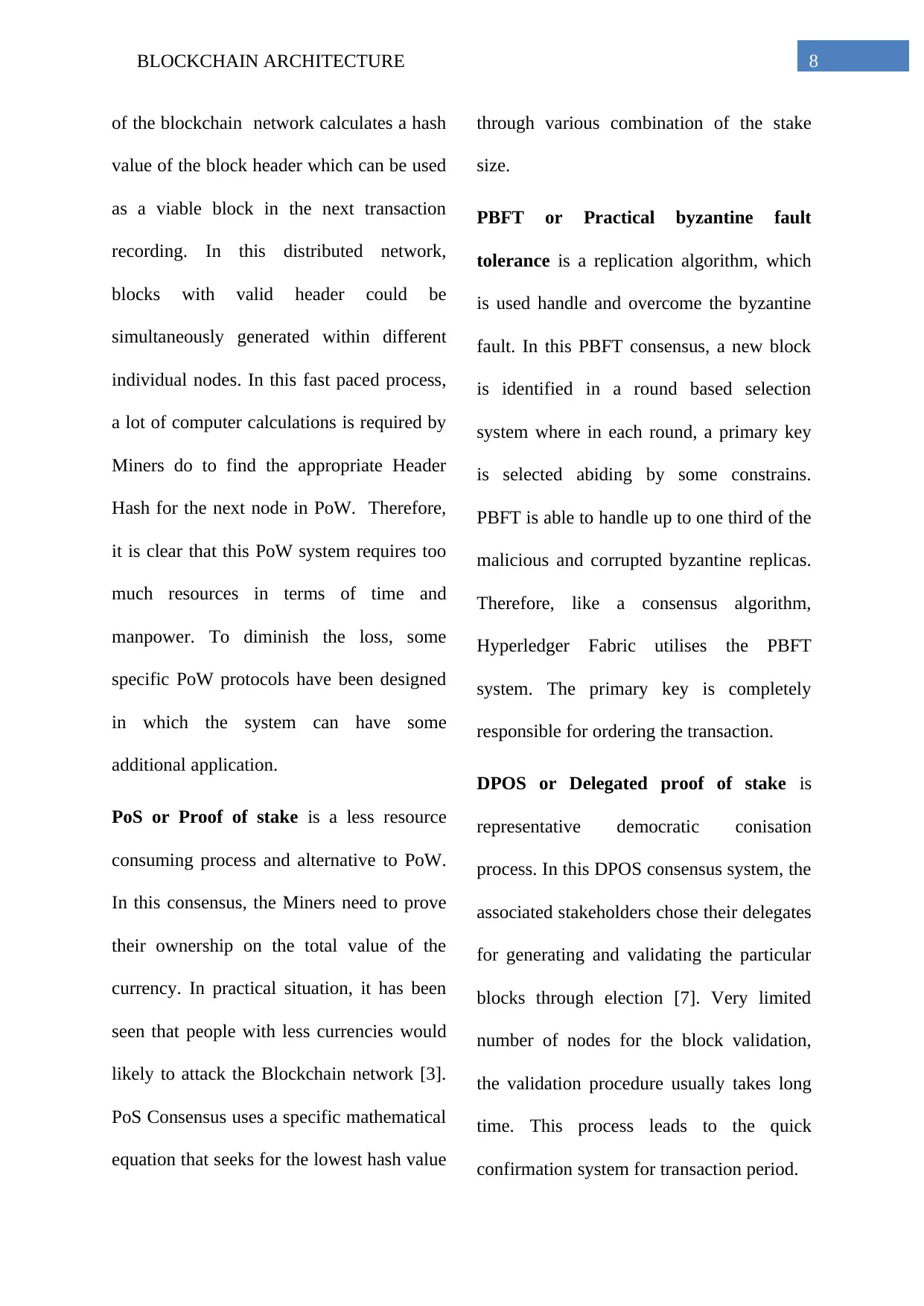
8BLOCKCHAIN ARCHITECTURE
of the blockchain network calculates a hash
value of the block header which can be used
as a viable block in the next transaction
recording. In this distributed network,
blocks with valid header could be
simultaneously generated within different
individual nodes. In this fast paced process,
a lot of computer calculations is required by
Miners do to find the appropriate Header
Hash for the next node in PoW. Therefore,
it is clear that this PoW system requires too
much resources in terms of time and
manpower. To diminish the loss, some
specific PoW protocols have been designed
in which the system can have some
additional application.
PoS or Proof of stake is a less resource
consuming process and alternative to PoW.
In this consensus, the Miners need to prove
their ownership on the total value of the
currency. In practical situation, it has been
seen that people with less currencies would
likely to attack the Blockchain network [3].
PoS Consensus uses a specific mathematical
equation that seeks for the lowest hash value
through various combination of the stake
size.
PBFT or Practical byzantine fault
tolerance is a replication algorithm, which
is used handle and overcome the byzantine
fault. In this PBFT consensus, a new block
is identified in a round based selection
system where in each round, a primary key
is selected abiding by some constrains.
PBFT is able to handle up to one third of the
malicious and corrupted byzantine replicas.
Therefore, like a consensus algorithm,
Hyperledger Fabric utilises the PBFT
system. The primary key is completely
responsible for ordering the transaction.
DPOS or Delegated proof of stake is
representative democratic conisation
process. In this DPOS consensus system, the
associated stakeholders chose their delegates
for generating and validating the particular
blocks through election [7]. Very limited
number of nodes for the block validation,
the validation procedure usually takes long
time. This process leads to the quick
confirmation system for transaction period.
of the blockchain network calculates a hash
value of the block header which can be used
as a viable block in the next transaction
recording. In this distributed network,
blocks with valid header could be
simultaneously generated within different
individual nodes. In this fast paced process,
a lot of computer calculations is required by
Miners do to find the appropriate Header
Hash for the next node in PoW. Therefore,
it is clear that this PoW system requires too
much resources in terms of time and
manpower. To diminish the loss, some
specific PoW protocols have been designed
in which the system can have some
additional application.
PoS or Proof of stake is a less resource
consuming process and alternative to PoW.
In this consensus, the Miners need to prove
their ownership on the total value of the
currency. In practical situation, it has been
seen that people with less currencies would
likely to attack the Blockchain network [3].
PoS Consensus uses a specific mathematical
equation that seeks for the lowest hash value
through various combination of the stake
size.
PBFT or Practical byzantine fault
tolerance is a replication algorithm, which
is used handle and overcome the byzantine
fault. In this PBFT consensus, a new block
is identified in a round based selection
system where in each round, a primary key
is selected abiding by some constrains.
PBFT is able to handle up to one third of the
malicious and corrupted byzantine replicas.
Therefore, like a consensus algorithm,
Hyperledger Fabric utilises the PBFT
system. The primary key is completely
responsible for ordering the transaction.
DPOS or Delegated proof of stake is
representative democratic conisation
process. In this DPOS consensus system, the
associated stakeholders chose their delegates
for generating and validating the particular
blocks through election [7]. Very limited
number of nodes for the block validation,
the validation procedure usually takes long
time. This process leads to the quick
confirmation system for transaction period.
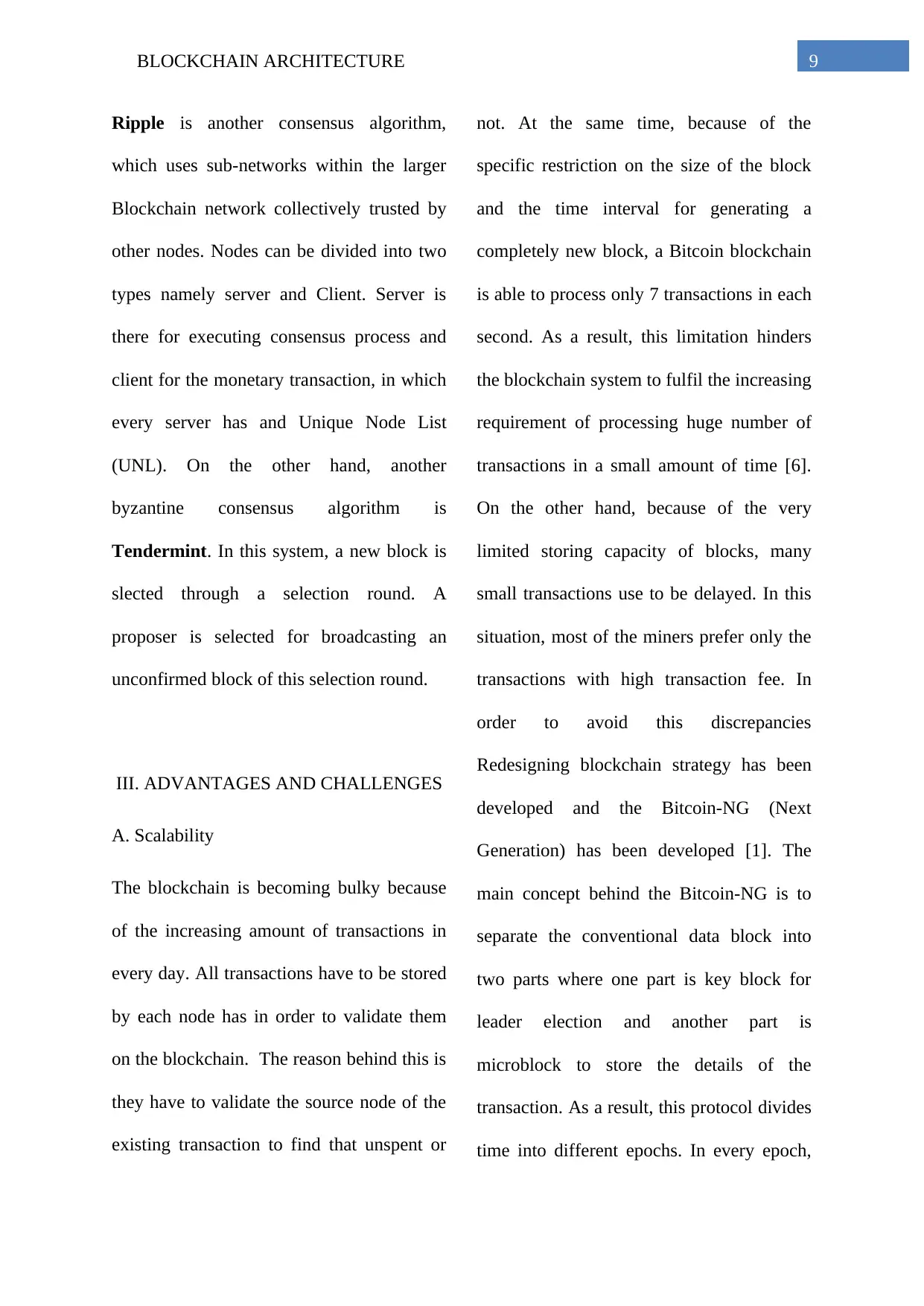
9BLOCKCHAIN ARCHITECTURE
Ripple is another consensus algorithm,
which uses sub-networks within the larger
Blockchain network collectively trusted by
other nodes. Nodes can be divided into two
types namely server and Client. Server is
there for executing consensus process and
client for the monetary transaction, in which
every server has and Unique Node List
(UNL). On the other hand, another
byzantine consensus algorithm is
Tendermint. In this system, a new block is
slected through a selection round. A
proposer is selected for broadcasting an
unconfirmed block of this selection round.
III. ADVANTAGES AND CHALLENGES
A. Scalability
The blockchain is becoming bulky because
of the increasing amount of transactions in
every day. All transactions have to be stored
by each node has in order to validate them
on the blockchain. The reason behind this is
they have to validate the source node of the
existing transaction to find that unspent or
not. At the same time, because of the
specific restriction on the size of the block
and the time interval for generating a
completely new block, a Bitcoin blockchain
is able to process only 7 transactions in each
second. As a result, this limitation hinders
the blockchain system to fulfil the increasing
requirement of processing huge number of
transactions in a small amount of time [6].
On the other hand, because of the very
limited storing capacity of blocks, many
small transactions use to be delayed. In this
situation, most of the miners prefer only the
transactions with high transaction fee. In
order to avoid this discrepancies
Redesigning blockchain strategy has been
developed and the Bitcoin-NG (Next
Generation) has been developed [1]. The
main concept behind the Bitcoin-NG is to
separate the conventional data block into
two parts where one part is key block for
leader election and another part is
microblock to store the details of the
transaction. As a result, this protocol divides
time into different epochs. In every epoch,
Ripple is another consensus algorithm,
which uses sub-networks within the larger
Blockchain network collectively trusted by
other nodes. Nodes can be divided into two
types namely server and Client. Server is
there for executing consensus process and
client for the monetary transaction, in which
every server has and Unique Node List
(UNL). On the other hand, another
byzantine consensus algorithm is
Tendermint. In this system, a new block is
slected through a selection round. A
proposer is selected for broadcasting an
unconfirmed block of this selection round.
III. ADVANTAGES AND CHALLENGES
A. Scalability
The blockchain is becoming bulky because
of the increasing amount of transactions in
every day. All transactions have to be stored
by each node has in order to validate them
on the blockchain. The reason behind this is
they have to validate the source node of the
existing transaction to find that unspent or
not. At the same time, because of the
specific restriction on the size of the block
and the time interval for generating a
completely new block, a Bitcoin blockchain
is able to process only 7 transactions in each
second. As a result, this limitation hinders
the blockchain system to fulfil the increasing
requirement of processing huge number of
transactions in a small amount of time [6].
On the other hand, because of the very
limited storing capacity of blocks, many
small transactions use to be delayed. In this
situation, most of the miners prefer only the
transactions with high transaction fee. In
order to avoid this discrepancies
Redesigning blockchain strategy has been
developed and the Bitcoin-NG (Next
Generation) has been developed [1]. The
main concept behind the Bitcoin-NG is to
separate the conventional data block into
two parts where one part is key block for
leader election and another part is
microblock to store the details of the
transaction. As a result, this protocol divides
time into different epochs. In every epoch,
Secure Best Marks with AI Grader
Need help grading? Try our AI Grader for instant feedback on your assignments.
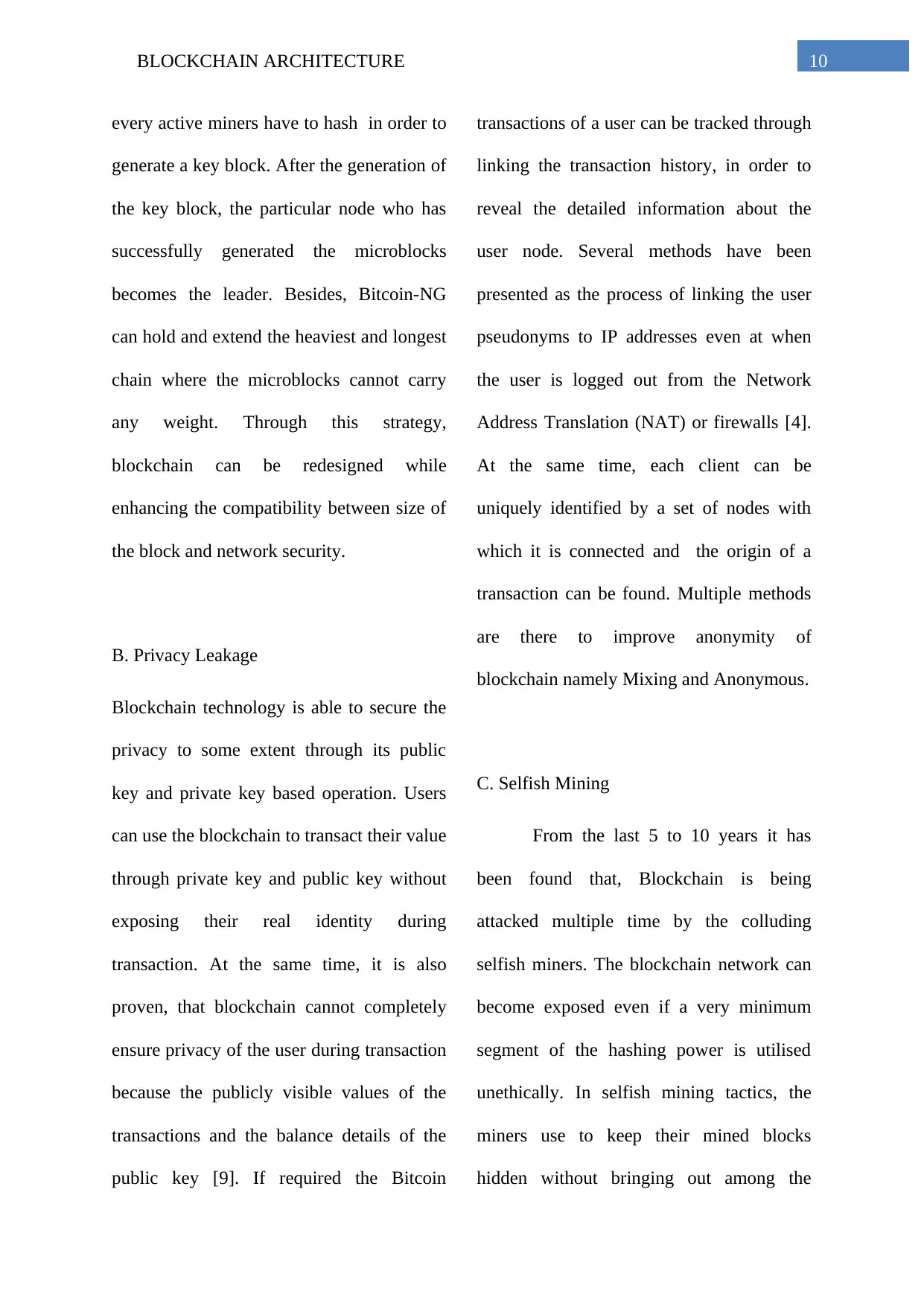
10BLOCKCHAIN ARCHITECTURE
every active miners have to hash in order to
generate a key block. After the generation of
the key block, the particular node who has
successfully generated the microblocks
becomes the leader. Besides, Bitcoin-NG
can hold and extend the heaviest and longest
chain where the microblocks cannot carry
any weight. Through this strategy,
blockchain can be redesigned while
enhancing the compatibility between size of
the block and network security.
B. Privacy Leakage
Blockchain technology is able to secure the
privacy to some extent through its public
key and private key based operation. Users
can use the blockchain to transact their value
through private key and public key without
exposing their real identity during
transaction. At the same time, it is also
proven, that blockchain cannot completely
ensure privacy of the user during transaction
because the publicly visible values of the
transactions and the balance details of the
public key [9]. If required the Bitcoin
transactions of a user can be tracked through
linking the transaction history, in order to
reveal the detailed information about the
user node. Several methods have been
presented as the process of linking the user
pseudonyms to IP addresses even at when
the user is logged out from the Network
Address Translation (NAT) or firewalls [4].
At the same time, each client can be
uniquely identified by a set of nodes with
which it is connected and the origin of a
transaction can be found. Multiple methods
are there to improve anonymity of
blockchain namely Mixing and Anonymous.
C. Selfish Mining
From the last 5 to 10 years it has
been found that, Blockchain is being
attacked multiple time by the colluding
selfish miners. The blockchain network can
become exposed even if a very minimum
segment of the hashing power is utilised
unethically. In selfish mining tactics, the
miners use to keep their mined blocks
hidden without bringing out among the
every active miners have to hash in order to
generate a key block. After the generation of
the key block, the particular node who has
successfully generated the microblocks
becomes the leader. Besides, Bitcoin-NG
can hold and extend the heaviest and longest
chain where the microblocks cannot carry
any weight. Through this strategy,
blockchain can be redesigned while
enhancing the compatibility between size of
the block and network security.
B. Privacy Leakage
Blockchain technology is able to secure the
privacy to some extent through its public
key and private key based operation. Users
can use the blockchain to transact their value
through private key and public key without
exposing their real identity during
transaction. At the same time, it is also
proven, that blockchain cannot completely
ensure privacy of the user during transaction
because the publicly visible values of the
transactions and the balance details of the
public key [9]. If required the Bitcoin
transactions of a user can be tracked through
linking the transaction history, in order to
reveal the detailed information about the
user node. Several methods have been
presented as the process of linking the user
pseudonyms to IP addresses even at when
the user is logged out from the Network
Address Translation (NAT) or firewalls [4].
At the same time, each client can be
uniquely identified by a set of nodes with
which it is connected and the origin of a
transaction can be found. Multiple methods
are there to improve anonymity of
blockchain namely Mixing and Anonymous.
C. Selfish Mining
From the last 5 to 10 years it has
been found that, Blockchain is being
attacked multiple time by the colluding
selfish miners. The blockchain network can
become exposed even if a very minimum
segment of the hashing power is utilised
unethically. In selfish mining tactics, the
miners use to keep their mined blocks
hidden without bringing out among the
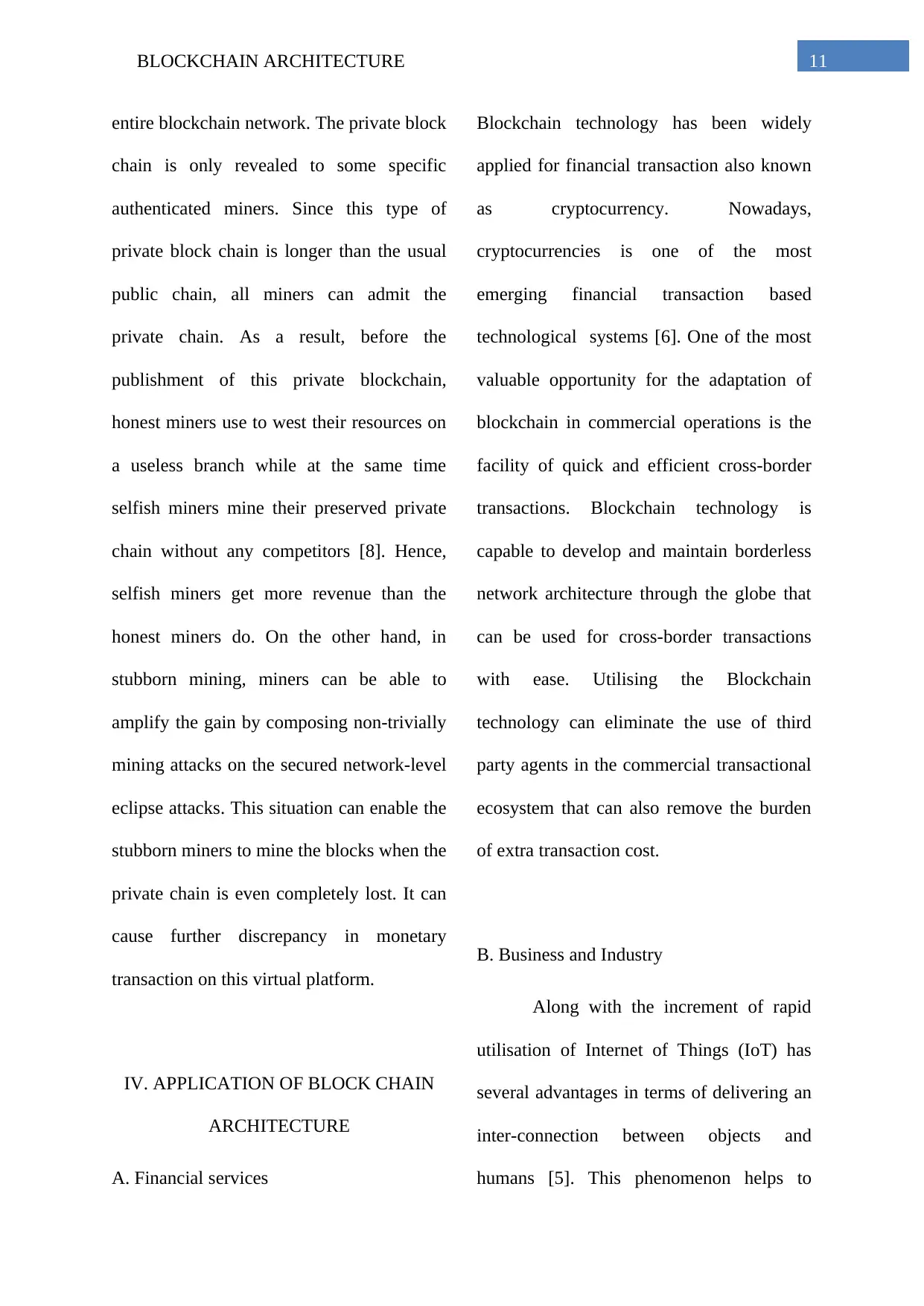
11BLOCKCHAIN ARCHITECTURE
entire blockchain network. The private block
chain is only revealed to some specific
authenticated miners. Since this type of
private block chain is longer than the usual
public chain, all miners can admit the
private chain. As a result, before the
publishment of this private blockchain,
honest miners use to west their resources on
a useless branch while at the same time
selfish miners mine their preserved private
chain without any competitors [8]. Hence,
selfish miners get more revenue than the
honest miners do. On the other hand, in
stubborn mining, miners can be able to
amplify the gain by composing non-trivially
mining attacks on the secured network-level
eclipse attacks. This situation can enable the
stubborn miners to mine the blocks when the
private chain is even completely lost. It can
cause further discrepancy in monetary
transaction on this virtual platform.
IV. APPLICATION OF BLOCK CHAIN
ARCHITECTURE
A. Financial services
Blockchain technology has been widely
applied for financial transaction also known
as cryptocurrency. Nowadays,
cryptocurrencies is one of the most
emerging financial transaction based
technological systems [6]. One of the most
valuable opportunity for the adaptation of
blockchain in commercial operations is the
facility of quick and efficient cross-border
transactions. Blockchain technology is
capable to develop and maintain borderless
network architecture through the globe that
can be used for cross-border transactions
with ease. Utilising the Blockchain
technology can eliminate the use of third
party agents in the commercial transactional
ecosystem that can also remove the burden
of extra transaction cost.
B. Business and Industry
Along with the increment of rapid
utilisation of Internet of Things (IoT) has
several advantages in terms of delivering an
inter-connection between objects and
humans [5]. This phenomenon helps to
entire blockchain network. The private block
chain is only revealed to some specific
authenticated miners. Since this type of
private block chain is longer than the usual
public chain, all miners can admit the
private chain. As a result, before the
publishment of this private blockchain,
honest miners use to west their resources on
a useless branch while at the same time
selfish miners mine their preserved private
chain without any competitors [8]. Hence,
selfish miners get more revenue than the
honest miners do. On the other hand, in
stubborn mining, miners can be able to
amplify the gain by composing non-trivially
mining attacks on the secured network-level
eclipse attacks. This situation can enable the
stubborn miners to mine the blocks when the
private chain is even completely lost. It can
cause further discrepancy in monetary
transaction on this virtual platform.
IV. APPLICATION OF BLOCK CHAIN
ARCHITECTURE
A. Financial services
Blockchain technology has been widely
applied for financial transaction also known
as cryptocurrency. Nowadays,
cryptocurrencies is one of the most
emerging financial transaction based
technological systems [6]. One of the most
valuable opportunity for the adaptation of
blockchain in commercial operations is the
facility of quick and efficient cross-border
transactions. Blockchain technology is
capable to develop and maintain borderless
network architecture through the globe that
can be used for cross-border transactions
with ease. Utilising the Blockchain
technology can eliminate the use of third
party agents in the commercial transactional
ecosystem that can also remove the burden
of extra transaction cost.
B. Business and Industry
Along with the increment of rapid
utilisation of Internet of Things (IoT) has
several advantages in terms of delivering an
inter-connection between objects and
humans [5]. This phenomenon helps to

12BLOCKCHAIN ARCHITECTURE
develop e-business architecture developed
for IoT environment. In this system, the
Distributed Autonomous Corporation
(DAC) can be used as an entity that gives
automated transaction services even in the
absence of human intervention. It also based
on autonomously peer to peer transaction
due to the blockchain technology. At the
same time, Many global business
organisations can adopt Bitcoin and IoTcoin
as the value change units and currency
system. In agri-food supply chain, the RFID
identification system and blockchain
technology can be used together in order to
increase the efficiency significantly [2]. On
the other hand, the cloud computing is
utilised as fog computing or edge
computing, has been used to develop a
transparent and fair value change and
transaction system using Bitcoin value
change and blockchain architecture.
C. Healthcare
Blockchain has a huge potential to address
the interoperability issues in the existing
healthcare systems. Blockchain can allow
the stakeholders of the healthcare service
namely healthcare entities, medical
researcher and others in order to share
electronic health record (EHR) through a
secured platform. Sharing of HER allows
the healthcare system to improve the overall
quality of medical care while enhancing the
recommended options for doctors. Besides,
to have better access of these issues, a
healthcare data gateway (HDG) can be made
based on the blockchain storage platform
[7]. This operational data architecture helps
to design new system to prioritize patient
urgency through MedRec. MedRec is
basically a distributed ledger protocol,
which can use public key cryptography to
create a new blockchain when required. The
particular blockchain can be replicated and
distributed across each node in the
healthcare network. Besides, blockchain
technology is also used to access control on
automatic system while tracking specific
tasks including appending a new record,
change in viewership rights and others
D. Governance
develop e-business architecture developed
for IoT environment. In this system, the
Distributed Autonomous Corporation
(DAC) can be used as an entity that gives
automated transaction services even in the
absence of human intervention. It also based
on autonomously peer to peer transaction
due to the blockchain technology. At the
same time, Many global business
organisations can adopt Bitcoin and IoTcoin
as the value change units and currency
system. In agri-food supply chain, the RFID
identification system and blockchain
technology can be used together in order to
increase the efficiency significantly [2]. On
the other hand, the cloud computing is
utilised as fog computing or edge
computing, has been used to develop a
transparent and fair value change and
transaction system using Bitcoin value
change and blockchain architecture.
C. Healthcare
Blockchain has a huge potential to address
the interoperability issues in the existing
healthcare systems. Blockchain can allow
the stakeholders of the healthcare service
namely healthcare entities, medical
researcher and others in order to share
electronic health record (EHR) through a
secured platform. Sharing of HER allows
the healthcare system to improve the overall
quality of medical care while enhancing the
recommended options for doctors. Besides,
to have better access of these issues, a
healthcare data gateway (HDG) can be made
based on the blockchain storage platform
[7]. This operational data architecture helps
to design new system to prioritize patient
urgency through MedRec. MedRec is
basically a distributed ledger protocol,
which can use public key cryptography to
create a new blockchain when required. The
particular blockchain can be replicated and
distributed across each node in the
healthcare network. Besides, blockchain
technology is also used to access control on
automatic system while tracking specific
tasks including appending a new record,
change in viewership rights and others
D. Governance
Paraphrase This Document
Need a fresh take? Get an instant paraphrase of this document with our AI Paraphraser
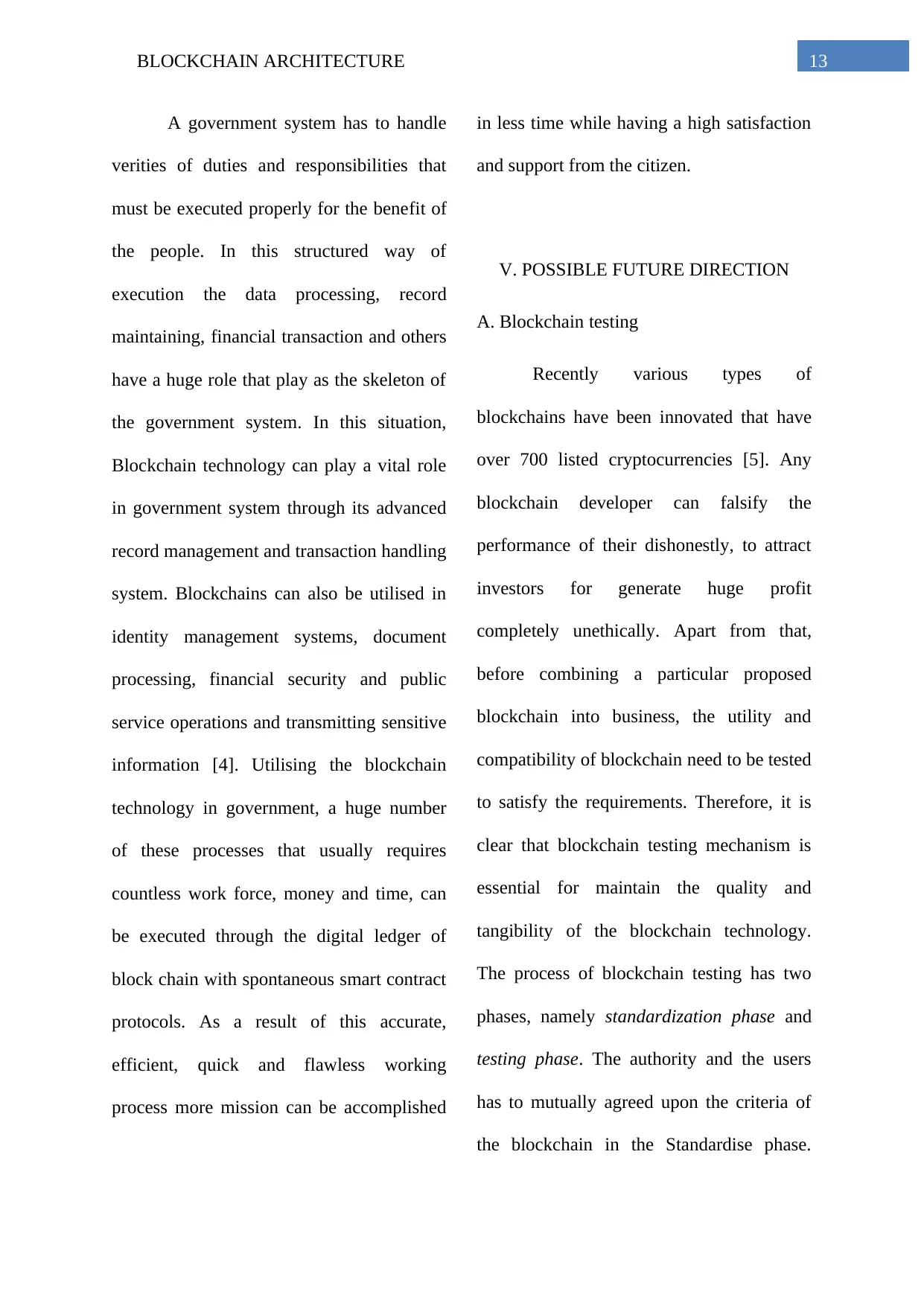
13BLOCKCHAIN ARCHITECTURE
A government system has to handle
verities of duties and responsibilities that
must be executed properly for the benefit of
the people. In this structured way of
execution the data processing, record
maintaining, financial transaction and others
have a huge role that play as the skeleton of
the government system. In this situation,
Blockchain technology can play a vital role
in government system through its advanced
record management and transaction handling
system. Blockchains can also be utilised in
identity management systems, document
processing, financial security and public
service operations and transmitting sensitive
information [4]. Utilising the blockchain
technology in government, a huge number
of these processes that usually requires
countless work force, money and time, can
be executed through the digital ledger of
block chain with spontaneous smart contract
protocols. As a result of this accurate,
efficient, quick and flawless working
process more mission can be accomplished
in less time while having a high satisfaction
and support from the citizen.
V. POSSIBLE FUTURE DIRECTION
A. Blockchain testing
Recently various types of
blockchains have been innovated that have
over 700 listed cryptocurrencies [5]. Any
blockchain developer can falsify the
performance of their dishonestly, to attract
investors for generate huge profit
completely unethically. Apart from that,
before combining a particular proposed
blockchain into business, the utility and
compatibility of blockchain need to be tested
to satisfy the requirements. Therefore, it is
clear that blockchain testing mechanism is
essential for maintain the quality and
tangibility of the blockchain technology.
The process of blockchain testing has two
phases, namely standardization phase and
testing phase. The authority and the users
has to mutually agreed upon the criteria of
the blockchain in the Standardise phase.
A government system has to handle
verities of duties and responsibilities that
must be executed properly for the benefit of
the people. In this structured way of
execution the data processing, record
maintaining, financial transaction and others
have a huge role that play as the skeleton of
the government system. In this situation,
Blockchain technology can play a vital role
in government system through its advanced
record management and transaction handling
system. Blockchains can also be utilised in
identity management systems, document
processing, financial security and public
service operations and transmitting sensitive
information [4]. Utilising the blockchain
technology in government, a huge number
of these processes that usually requires
countless work force, money and time, can
be executed through the digital ledger of
block chain with spontaneous smart contract
protocols. As a result of this accurate,
efficient, quick and flawless working
process more mission can be accomplished
in less time while having a high satisfaction
and support from the citizen.
V. POSSIBLE FUTURE DIRECTION
A. Blockchain testing
Recently various types of
blockchains have been innovated that have
over 700 listed cryptocurrencies [5]. Any
blockchain developer can falsify the
performance of their dishonestly, to attract
investors for generate huge profit
completely unethically. Apart from that,
before combining a particular proposed
blockchain into business, the utility and
compatibility of blockchain need to be tested
to satisfy the requirements. Therefore, it is
clear that blockchain testing mechanism is
essential for maintain the quality and
tangibility of the blockchain technology.
The process of blockchain testing has two
phases, namely standardization phase and
testing phase. The authority and the users
has to mutually agreed upon the criteria of
the blockchain in the Standardise phase.

14BLOCKCHAIN ARCHITECTURE
After the creation of each blockchain, it can
be tested through utilising the criteria chart
agreed mutually in order to test the
functionality of the particular blockchain as
per the developer’s claims. Similarly in the
testing phase, the testers need to perform
with different criteria supported by the
platform integrity and accuracy
measurement.
B. De-centralization
The design of Blockchain
Architecture is based on distributed network
system. However, there is a trend within the
global miners to centralised the Blockchain
network in the mining pool by rewriting the
link and station addresses. This
centralisation can be destructive for the
security of the privacy assurance of
blockchain based network system.
Surprisingly, the top 5 bitcoin mining pools
have the ownership of more than 51% of the
total hash power across the global Bitcoin
network [2]. At the same time, through
strategy of selfish mining, pools, which have
more than 25% of total computing power,
are able to generate more revenue. On the
other hand, rational miners or honest miners
may become attracted to the selfish pool.
After this, with higher number of selfish
miner the pool could easily overshoot the
51% of the total ownership power in global
Blockchain network. For preventing these
situations, strategic methods are required, to
make the Blockchain Network completely
decentralised and distributed.
C. Big data analytics
Blockchain can be structurally
combined with big data in order to increase
the efficiency and utilisation o both
technologies. These utilisations can be
categorised into two different type of
operations namely data management and
data analytics. In data management
operation, blockchain could be used to store
data, which would be securely distributed
within the network [7]. Blockchain is also
able to maintain the originality of the data.
As an example, if a particular blockchain is
After the creation of each blockchain, it can
be tested through utilising the criteria chart
agreed mutually in order to test the
functionality of the particular blockchain as
per the developer’s claims. Similarly in the
testing phase, the testers need to perform
with different criteria supported by the
platform integrity and accuracy
measurement.
B. De-centralization
The design of Blockchain
Architecture is based on distributed network
system. However, there is a trend within the
global miners to centralised the Blockchain
network in the mining pool by rewriting the
link and station addresses. This
centralisation can be destructive for the
security of the privacy assurance of
blockchain based network system.
Surprisingly, the top 5 bitcoin mining pools
have the ownership of more than 51% of the
total hash power across the global Bitcoin
network [2]. At the same time, through
strategy of selfish mining, pools, which have
more than 25% of total computing power,
are able to generate more revenue. On the
other hand, rational miners or honest miners
may become attracted to the selfish pool.
After this, with higher number of selfish
miner the pool could easily overshoot the
51% of the total ownership power in global
Blockchain network. For preventing these
situations, strategic methods are required, to
make the Blockchain Network completely
decentralised and distributed.
C. Big data analytics
Blockchain can be structurally
combined with big data in order to increase
the efficiency and utilisation o both
technologies. These utilisations can be
categorised into two different type of
operations namely data management and
data analytics. In data management
operation, blockchain could be used to store
data, which would be securely distributed
within the network [7]. Blockchain is also
able to maintain the originality of the data.
As an example, if a particular blockchain is

15BLOCKCHAIN ARCHITECTURE
used to store the health related detailed
information of the patients. The stored
information in blockchain cannot be altered
of deleted and even stolen. For data
analytics process, and data transactions the
blockchain technology could be used as a
integrated system in big data analytics. As
an example, the user trading patterns can be
extracted and stored in a cloud network. By
analysing this data, the users can predict the
potential trading behaviours of their partners
very easily.
VI. CONCLUSION
The purpose of this paper was to
analyse the various essential components of
the blockchain technology including the
architecture, utility, optimisation and others
in order to find the future direction of
improvement. From the discussion it has
been found that, Blockchain technology has
become on f the most emerging technologies
especially in the business transition and
value change operation. This new
technology advances the assets exchange
operation across the globe while assuring the
security, privacy and the optimization. It has
been also found that blockchain architecture
changes the way of network based database
works while increasing the number of
utilisers up to enormous level. Several new
implementation such as cryptocurrency,
Bicton mining, crypto-wallet, Hash code
generation, digital signatures and others are
becoming more and more popular.
It has been found from the above
discussion that the address of the block is
encrypted in a Hash address, which can be
decrypted through authorised permission
known as Privet Key. Consensus is specific
way of operation through which the
transaction details and its validity could be
easily verified and tracked. Consensus
Algorithms is the problem solving approach
of the Consensus related problem in
Blockchain operation. Along with the
popularity of using Internet of Things (IoT),
it has brought many advantages that enhance
the accessibility and the utility of the
network based database system. It has been
used to store the health related detailed
information of the patients. The stored
information in blockchain cannot be altered
of deleted and even stolen. For data
analytics process, and data transactions the
blockchain technology could be used as a
integrated system in big data analytics. As
an example, the user trading patterns can be
extracted and stored in a cloud network. By
analysing this data, the users can predict the
potential trading behaviours of their partners
very easily.
VI. CONCLUSION
The purpose of this paper was to
analyse the various essential components of
the blockchain technology including the
architecture, utility, optimisation and others
in order to find the future direction of
improvement. From the discussion it has
been found that, Blockchain technology has
become on f the most emerging technologies
especially in the business transition and
value change operation. This new
technology advances the assets exchange
operation across the globe while assuring the
security, privacy and the optimization. It has
been also found that blockchain architecture
changes the way of network based database
works while increasing the number of
utilisers up to enormous level. Several new
implementation such as cryptocurrency,
Bicton mining, crypto-wallet, Hash code
generation, digital signatures and others are
becoming more and more popular.
It has been found from the above
discussion that the address of the block is
encrypted in a Hash address, which can be
decrypted through authorised permission
known as Privet Key. Consensus is specific
way of operation through which the
transaction details and its validity could be
easily verified and tracked. Consensus
Algorithms is the problem solving approach
of the Consensus related problem in
Blockchain operation. Along with the
popularity of using Internet of Things (IoT),
it has brought many advantages that enhance
the accessibility and the utility of the
network based database system. It has been
Secure Best Marks with AI Grader
Need help grading? Try our AI Grader for instant feedback on your assignments.

16BLOCKCHAIN ARCHITECTURE
found that Blockchain can become useless
because of unethical operation of selfish
miners. However, with appropriate problem
solving strategy and decentralisation the
blockchain architecture can be used in
financial service, health services, business
operations and even in Government system.
Apart from that, Blockchain can be
structurally combined with big data in order
to increase the efficiency and utilisation o
both technologies.
found that Blockchain can become useless
because of unethical operation of selfish
miners. However, with appropriate problem
solving strategy and decentralisation the
blockchain architecture can be used in
financial service, health services, business
operations and even in Government system.
Apart from that, Blockchain can be
structurally combined with big data in order
to increase the efficiency and utilisation o
both technologies.

17BLOCKCHAIN ARCHITECTURE
REFERENCE:
[1] V. Dhillon, D. Metcalf, and M. Hooper,
“Foundations of Blockchain,” Blockchain
Enabled Applications, pp. 15–24, 2017.
[2] Z. Zheng, S. Xie, H. Dai, X. Chen, and
H. Wang, “An Overview of Blockchain
Technology: Architecture, Consensus, and
Future Trends,” 2017 IEEE International
Congress on Big Data (BigData Congress),
2017.
[3] X. Xu, I. Weber, M. Staples, L. Zhu, J.
Bosch, L. Bass, C. Pautasso, and P. Rimba,
“A Taxonomy of Blockchain-Based Systems
for Architecture Design,” 2017 IEEE
International Conference on Software
Architecture (ICSA), 2017.
[4] C. D. Clack, “A Blockchain Grand
Challenge: Smart Financial
Derivatives,” Frontiers in Blockchain, vol.
1, 2018.
[5] I. Eyal, “Blockchain Technology:
Transforming Libertarian Cryptocurrency
Dreams to Finance and Banking
Realities,” Computer, vol. 50, no. 9, pp. 38–
49, 2017.
[6] H. Hassani, X. Huang, and E. Silva,
“Big-Crypto: Big Data, Blockchain and
Cryptocurrency,” Big Data and Cognitive
Computing, vol. 2, no. 4, p. 34, 2018.
[7] S. Corbet, C. J. Larkin, B. M. Lucey, and
L. Yarovaya, “Kodakcoin: A Blockchain
Revolution or Exploiting a Potential
Cryptocurrency Bubble?,” SSRN Electronic
Journal, 2018.
[8] V. Dhillon, D. Metcalf, and M. Hooper,
“Recent Developments in
Blockchain,” Blockchain Enabled
Applications, pp. 151–181, 2017.
[9] M. V. Rijmenam, “Blockchain and Fair
Trade,” Blockchain, pp. 114–124.
[10] V. Morabito, “Blockchain Value
System,” Business Innovation Through
Blockchain, pp. 21–39, 2017.
REFERENCE:
[1] V. Dhillon, D. Metcalf, and M. Hooper,
“Foundations of Blockchain,” Blockchain
Enabled Applications, pp. 15–24, 2017.
[2] Z. Zheng, S. Xie, H. Dai, X. Chen, and
H. Wang, “An Overview of Blockchain
Technology: Architecture, Consensus, and
Future Trends,” 2017 IEEE International
Congress on Big Data (BigData Congress),
2017.
[3] X. Xu, I. Weber, M. Staples, L. Zhu, J.
Bosch, L. Bass, C. Pautasso, and P. Rimba,
“A Taxonomy of Blockchain-Based Systems
for Architecture Design,” 2017 IEEE
International Conference on Software
Architecture (ICSA), 2017.
[4] C. D. Clack, “A Blockchain Grand
Challenge: Smart Financial
Derivatives,” Frontiers in Blockchain, vol.
1, 2018.
[5] I. Eyal, “Blockchain Technology:
Transforming Libertarian Cryptocurrency
Dreams to Finance and Banking
Realities,” Computer, vol. 50, no. 9, pp. 38–
49, 2017.
[6] H. Hassani, X. Huang, and E. Silva,
“Big-Crypto: Big Data, Blockchain and
Cryptocurrency,” Big Data and Cognitive
Computing, vol. 2, no. 4, p. 34, 2018.
[7] S. Corbet, C. J. Larkin, B. M. Lucey, and
L. Yarovaya, “Kodakcoin: A Blockchain
Revolution or Exploiting a Potential
Cryptocurrency Bubble?,” SSRN Electronic
Journal, 2018.
[8] V. Dhillon, D. Metcalf, and M. Hooper,
“Recent Developments in
Blockchain,” Blockchain Enabled
Applications, pp. 151–181, 2017.
[9] M. V. Rijmenam, “Blockchain and Fair
Trade,” Blockchain, pp. 114–124.
[10] V. Morabito, “Blockchain Value
System,” Business Innovation Through
Blockchain, pp. 21–39, 2017.
1 out of 18
Related Documents
Your All-in-One AI-Powered Toolkit for Academic Success.
+13062052269
info@desklib.com
Available 24*7 on WhatsApp / Email
![[object Object]](/_next/static/media/star-bottom.7253800d.svg)
Unlock your academic potential
© 2024 | Zucol Services PVT LTD | All rights reserved.




